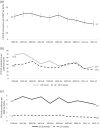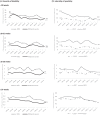Declining trends in birth prevalence and severity of singletons with cerebral palsy of prenatal or perinatal origin in Australia: A population-based observational study
- PMID: 35261024
- PMCID: PMC9544021
- DOI: 10.1111/dmcn.15195
Declining trends in birth prevalence and severity of singletons with cerebral palsy of prenatal or perinatal origin in Australia: A population-based observational study
Abstract
Aim: To investigate temporal trends in birth prevalence, disability severity, and motor type for singletons with prenatal or perinatally acquired cerebral palsy (CP).
Method: Numerator data, number of children with CP born a singleton between 1995 and 2014, confirmed at 5 years of age, were drawn from three state registers with population-level ascertainment. Birth prevalence estimates and 95% confidence intervals (CI) were calculated per 1000 singleton live births for the three states combined, overall, by gestational age group, by dichotomized disability severity, and spastic laterality. Poisson regression models were used to analyse trends. Using data from all eight registers, trends in the proportional distribution of CP subtypes overall and stratified by gestational age were examined.
Results: Birth prevalence of CP declined from 1.8 (95% CI 1.6-2.0) in 1995 to 1996 to 1.2 (95% CI 1.1-1.4) in 2013 to 2014 (average 5% per 2-year epoch, p < 0.001). Declines in birth prevalence were observed across all gestational age groups with the largest decline in children born at <28 weeks (average 8% per epoch, p < 0.001). Prevalence of moderate-severe disability declined for children born at <28 and ≥37 weeks (average 11% and 7% per epoch respectively, p < 0.001). The proportions of bilateral spastic CP declined (p < 0.001) at <28 weeks (p = 0.014) and ≥37 weeks (p < 0.001). The proportion of children with dyskinesia increased (28-31 weeks: p = 0.021, 32-36 weeks: p = 0.001, and ≥37 weeks: p < 0.001).
Interpretation: Birth prevalence of CP and moderate-severe disability (<28 and ≥37 weeks) declined in Australian singletons between 1995 and 2014, reflecting changes in prenatal and perinatal care over time.
What this paper adds: Declines in birth prevalence of prenatal or perinatally acquired cerebral palsy were observed for singletons born in Australia between 1995 and 2014. These declines were evident across all gestational age groups. Declines in birth prevalence of moderate-severe disability were observed for children born at <28 weeks and ≥37 weeks.
© 2022 The Authors. Developmental Medicine & Child Neurology published by John Wiley & Sons Ltd on behalf of Mac Keith Press.
Figures


Comment in
-
Changing trends in cerebral palsy prevalence: an opportunity to consider etiological pathways.Dev Med Child Neurol. 2022 Sep;64(9):1054-1055. doi: 10.1111/dmcn.15223. Epub 2022 Mar 23. Dev Med Child Neurol. 2022. PMID: 35322400 Free PMC article.
Similar articles
-
Cerebral palsy trends in Australia (1995-2009): a population-based observational study.Dev Med Child Neurol. 2019 Feb;61(2):186-193. doi: 10.1111/dmcn.14011. Epub 2018 Sep 6. Dev Med Child Neurol. 2019. PMID: 30187914
-
Cerebral palsy in Australia: birth prevalence, 1995-2016, and differences by residential remoteness: a population-based register study.Med J Aust. 2024 Nov 18;221(10):533-539. doi: 10.5694/mja2.52487. Epub 2024 Oct 30. Med J Aust. 2024. PMID: 39478298
-
Cerebral palsy in twins and higher multiple births: a Europe-Australia population-based study.Dev Med Child Neurol. 2021 Jun;63(6):712-720. doi: 10.1111/dmcn.14827. Epub 2021 Feb 2. Dev Med Child Neurol. 2021. PMID: 33533028
-
Global prevalence of cerebral palsy: A systematic analysis.Dev Med Child Neurol. 2022 Dec;64(12):1494-1506. doi: 10.1111/dmcn.15346. Epub 2022 Aug 11. Dev Med Child Neurol. 2022. PMID: 35952356 Free PMC article.
-
Perinatal care with a view to preventing cerebral palsy.Dev Med Child Neurol. 2021 Feb;63(2):156-161. doi: 10.1111/dmcn.14754. Epub 2020 Nov 29. Dev Med Child Neurol. 2021. PMID: 33251607 Free PMC article. Review.
Cited by
-
Prevalence and trends for Aboriginal and Torres Strait Islander children living with cerebral palsy: A birds-eye view.Dev Med Child Neurol. 2023 Nov;65(11):1475-1485. doi: 10.1111/dmcn.15617. Epub 2023 May 5. Dev Med Child Neurol. 2023. PMID: 37147854 Free PMC article.
-
Adults with Cerebral Palsy: Navigating the Complexities of Aging.Brain Sci. 2023 Sep 8;13(9):1296. doi: 10.3390/brainsci13091296. Brain Sci. 2023. PMID: 37759897 Free PMC article. Review.
-
Increasing prevalence of cerebral palsy in children born very preterm in Denmark.Dev Med Child Neurol. 2025 Jan;67(1):68-76. doi: 10.1111/dmcn.16020. Epub 2024 Jul 12. Dev Med Child Neurol. 2025. PMID: 38994777 Free PMC article.
-
Key roles of glial cells in the encephalopathy of prematurity.Glia. 2024 Mar;72(3):475-503. doi: 10.1002/glia.24474. Epub 2023 Nov 1. Glia. 2024. PMID: 37909340 Free PMC article. Review.
-
Early developmental trajectories of the impaired hand in infants with unilateral cerebral palsy.Dev Med Child Neurol. 2025 Jul;67(7):901-909. doi: 10.1111/dmcn.16240. Epub 2025 Jan 18. Dev Med Child Neurol. 2025. PMID: 39826100 Free PMC article. Clinical Trial.
References
-
- Rosenbaum P, Paneth N, Leviton A, Goldstein M, Bax M. A report: the definition and classification of cerebral palsy April 2006. Dev Med Child Neurol. 2007;49:8–14. - PubMed
-
- ACPR Group . Report of the Australian Cerebral Palsy Register Birth Years 1995‐2012; 2018. Available from: https://cpregister.com/wp‐content/uploads/2019/02/Report‐of‐the‐Australi... (Accessed 2nd December 2021).
-
- Khandaker G, Muhit M, Karim T, Smithers‐Sheedy H, Novak I, Jones C, Badawi N. Epidemiology of cerebral palsy in Bangladesh: a population‐based surveillance study. Dev Med Child Neurol. 2019;61(5):601–9. - PubMed
-
- Reid SM, Meehan E, McIntyre S, Goldsmith S, Badawi N, Reddihough DS. Temporal trends in cerebral palsy by impairment severity and birth gestation. Dev Med Child Neurol. 2016;58(Suppl 2):25–35. - PubMed
Publication types
MeSH terms
LinkOut - more resources
Full Text Sources
Medical
Miscellaneous

